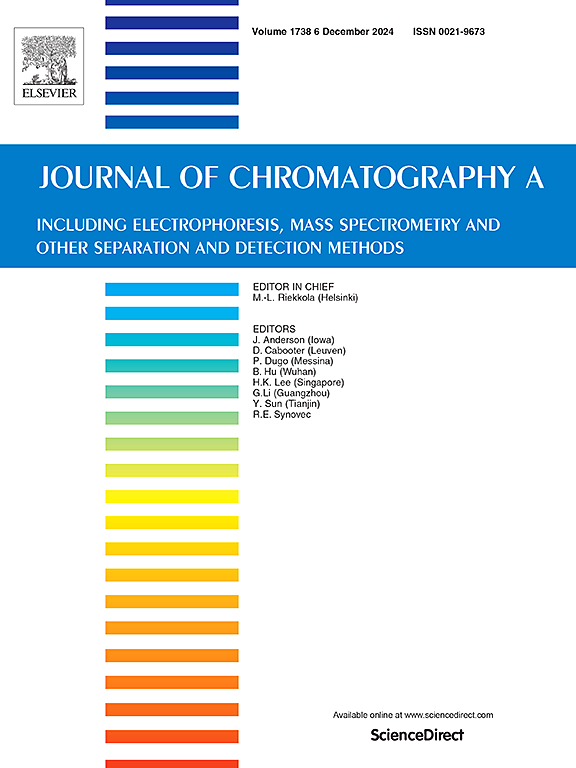Off-line in-tube solid-phase microextraction of some herbicides based on poly(styrene-divinylbenzene) coated Fe3O4 nanoparticles
IF 3.8
2区 化学
Q1 BIOCHEMICAL RESEARCH METHODS
引用次数: 0
Abstract
Triazines are a class of persistent micropollutants in environmental areas with high toxicity. Because of their general usage and poisonous and stability of their deteriorated products, extraction and determination trace amounts of triazines are important. Off-line in-tube solid phase microextraction efficiently used for extraction of trace amounts of analytes. In addition, magnetic field was used to keep the nanoparticles in the tube and also to enhance preconcentration of the analytes. Magnetic nanoparticles can be utilized as a reusable sorbent with high surface area, strong interaction, chemical stability and high selectivity.
A novel approach was introduced using a magnetic nanocomposite of cross-linked poly(styrene-divinylbenzene) for the in-tube solid-phase microextraction of triazine herbicides. The prepared material was characterized using various techniques. High performance liquid chromatography-ultraviolet detection was used to separate and determine the analytes. The effects of pH (6), extraction time (20 min), type and volume of elution solvent (500 µL methanol) and extraction flow rate (2 mL min-1), desorption flow rate (50 µL min-1) and salt addition (15%) and applying magnetic field on the extraction efficiency of the triazines were investigated. Under optimum conditions, calibration curves were found to be linear in the range of 0.3-500 µg L−1 for cyanazine, simazine, and propazine with a coefficient of determination (R2) of 0.9951, 0.9984, and 0.9984, respectively. The LODs were 0.1 µg L−1 for all of the analytes. The method was successfully used for the extraction and determination of triazine herbicides in fruit juice samples.
Magnetic nano particles illustrate minimum back pressure in tube due to elimination of filters, high surface-to-volume ratio and lot of active sites favorable for the adsorption of the analytes. Despite the limitations imposed by the chemical conditions of extraction on the application of nanoparticles and polymeric sorbents, variables such as pH, concentration, and surface charges do not influence the magnetic interactions of MNPs. By applying magnetic field, the magnetic nature of the analytes is effective on the preconcentration of them.
基于聚苯乙烯-二乙烯基苯包被Fe3O4纳米颗粒的管内固相微萃取除草剂
三嗪类是一类高毒性环境区域的持久性微污染物。由于其用途广泛,变质产物的毒性和稳定性,微量三嗪的提取和测定具有重要意义。离线管内固相微萃取有效地用于萃取痕量分析物。此外,利用磁场将纳米颗粒保持在管中,并增强分析物的预富集。磁性纳米颗粒具有高表面积、强相互作用、化学稳定性和高选择性等特点,是一种可重复使用的吸附剂。采用交联聚苯乙烯-二乙烯基苯磁性纳米复合材料制备了一种管内固相微萃取三嗪类除草剂的方法。用各种方法对所制备的材料进行了表征。采用高效液相色谱-紫外检测对分析物进行分离测定。考察了pH(6)、提取时间(20 min)、洗脱溶剂种类和体积(500µL甲醇)、提取流速(2 mL min-1)、解吸流速(50µL min-1)、加盐量(15%)和外加磁场对三嗪类化合物提取效率的影响。在最佳条件下,在0.3 ~ 500µg L−1范围内,氰嗪、西玛嗪和丙嗪的校准曲线均呈线性,决定系数(R2)分别为0.9951、0.9984和0.9984。所有分析物的lod均为0.1µg L−1。该方法可用于果汁样品中三嗪类除草剂的提取和测定。磁性纳米颗粒由于消除了过滤器、高表面体积比和大量有利于被分析物吸附的活性位点而具有最小的管内背压。尽管萃取的化学条件对纳米颗粒和聚合物吸附剂的应用施加了限制,但诸如pH值、浓度和表面电荷等变量并不影响MNPs的磁相互作用。通过施加磁场,分析物的磁性对其富集是有效的。
本文章由计算机程序翻译,如有差异,请以英文原文为准。
求助全文
约1分钟内获得全文
求助全文
来源期刊

Journal of Chromatography A
化学-分析化学
CiteScore
7.90
自引率
14.60%
发文量
742
审稿时长
45 days
期刊介绍:
The Journal of Chromatography A provides a forum for the publication of original research and critical reviews on all aspects of fundamental and applied separation science. The scope of the journal includes chromatography and related techniques, electromigration techniques (e.g. electrophoresis, electrochromatography), hyphenated and other multi-dimensional techniques, sample preparation, and detection methods such as mass spectrometry. Contributions consist mainly of research papers dealing with the theory of separation methods, instrumental developments and analytical and preparative applications of general interest.
 求助内容:
求助内容: 应助结果提醒方式:
应助结果提醒方式:


